HOLOGRAMS AND STEREO PAINTINGS Margaret Benyon
13th November 2001- 4th January 2002
November 2001
HOLOGRAMS AND STEREO PAINTINGS Margaret Benyon
13th November 2001- 4th January 2002
The 'Cornucopia' section of this exhibition was extended until the first week in January 2002.
Viewing by appointment
Private Views took place on:
Tuesday November 13th, 6.30 -8.30
Thursday November 15th, 6.30 -8.30
Sunday November 18th, 12 noon - 3pm
The desire to mount this exhibition was kindled when I attended the opening of Margaret’s Cornucopia show at the Russell-Cotes Art Gallery & Museum in Bournemouth in July 1996. It was a couple of years before I was to open Gallery 286, but I was determined that the work should be seen by a London audience at some time in the not too distant future.

Web 1970, stereo painting, 24ft (7.3m), polyvinyl-acetate on canvas. On view in the exhibition from 13th November until 6th December only
I first met Margaret in 1980, two years after I first became involved with holography. She had been living in Australia and had just moved back to the UK. Everyone working with holography knew her by reputation as she had pioneered the use of the medium for fine art but she had not showed in London since 1970 and in the end I had to visit the Museum of Holography in New York (now at MIT) to see any of her work.

Web 1993, 50 x 60cm loose film reflection hologram
Astonishingly, although she has taken part in over one hundred shows around the world, and been awarded the MBE for her services to art, this is still her first solo exhibition in London since 1970 and I am very proud to be holding it at 286.
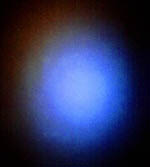
Blue 1993, 50 x 60cm loose film reflection hologram
Over the years I have come to know Margaret as a friend and have managed to acquire a sizeable holding of her work for my private collection. I admire her enormously for her dedication, her perfectionism and for the seriousness and beauty of her work. Collecting holograms is not a mainstream activity and the medium has not yet been tested by time and the auction houses, but when the history of artists working with holography in the late 20th and early 21st century is written, you can be sure that Margaret Benyon’s name will feature prominently.
Jonathan Ross
British hologram collector Jonathan Ross presents selections from Margaret Benyon's holographic series Cornucopia for its first London showing, along with Web, a very large stereo painting made in the late 1960's.
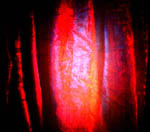
Curtain 1993, 50 x 60cm reflection hologram in blue and red
Margaret Benyon is a British artist who was a painter for some years after leaving the Slade, before pioneering holography as an art medium in the late '60's. She is now a well-known leading light in the field, with a doctorate from the RCA, state recognition in the form of an MBE, and a current entry in Who's Who International. She has shown in over a hundred exhibitions world-wide, and her work is in public collections. She works internationally, exhibiting, lecturing, and making holograms mainly in her studio on the Dorset coast - one of very few non-commercial holographic studios in existence.
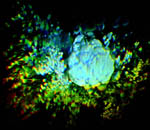
Cornucopia CauliFlowers 1993, Open-aperture film transmission hologram, 50 x 60cm
Web is a large stereo painting installed on all three walls of the upstairs gallery, part of which was first shown at the Lisson Gallery London in 1970. This work overlaps with Benyon's early transition into holography as a medium. Echoes of early preoccupations survive in current work.

Cornucopia Shells 1993, Open-aperture film transmission hologram 50 x 60cm and collage
Cornucopia is an ongoing holographic project which explores the proposition that everything in the world around us can be defined as 'natural', but that we see some things as more 'natural' than others. Images of trees and mountains are seemingly less 'made' by people than concrete or machines. The images in the Cornucopia holograms are chosen for their hologenic and sensuous appeal. Combined together they are intended to re-contextualise the hologram as organic and easy to live with, rather than the product of an alien technology. As Cornucopia suggests natural abundance, another theme in the series is to explore how some aspects of 'abundance' - fertility, decoration, chaos or lack of rationality - have been seen negatively and used to define female roles and characteristics. In un-picking such biases, many contemporary women artists have emphasized the importance of links between personal and political experience, so that women's experiences can be understood and asserted. The series explores bringing together what may be seen as feminine and masculine characteristics. Technology, which is often stereotyped as hard and masculine, is used to create images that relate to female concerns and perceptions of the world.
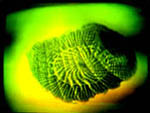
Cornucopia 1994, Holographic stereogram, 8" x 10"
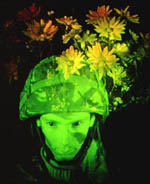
Pushing up the Daisies 1996, 60 x 80cm reflection film collage with text
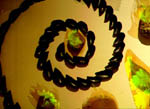
Rock Garden 1996, Small limestone rocks ground to a flat surface on one side with loose film holograms of lowers resting on the flat surface, arranged with a spiral of blue mussel shells.
Details about Margaret Benyon's work can also be found at the Benyon Archive
www.mbenyon.com
This email address is being protected from spambots. You need JavaScript enabled to view it.
The Jonathan Ross Hologram Collection website has been running for fifteen years so we decided it was time for a new look.
The new format has scope for lots more material so I would like to invite all the holographers whose work is featured here to submit background information, stories and images to supplement those I have provided. That way we can work together to make this the best resource on holographic imaging to be found on the web.
The Jonathan Ross Hologram Collection, based in London, UK, is one of the largest resources in the world for creative, display and commercial holography.
A number of touring exhibitions, containing work from the collection, have been presented in outstanding museums and galleries both within the UK and abroad. Information about new acquisitions and exhibitions is added here on a regular basis.